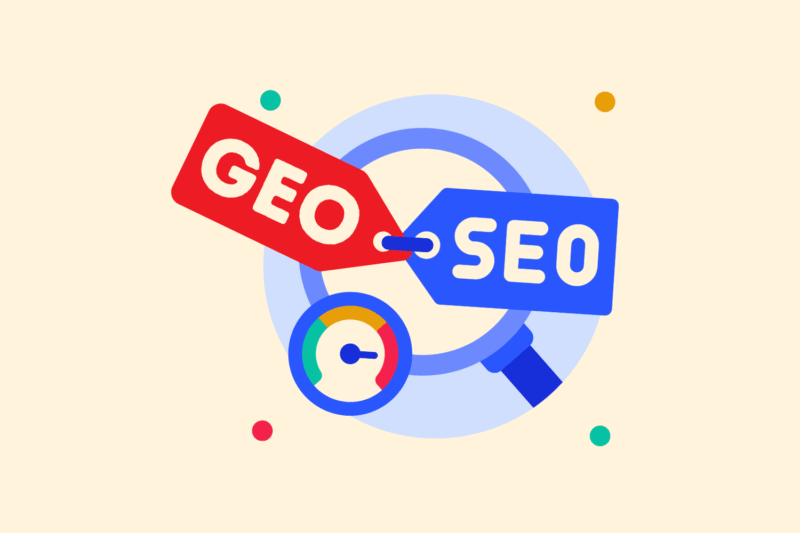GEO versus traditional SEO: the key differences

The rise of AI search engines such as ChatGPT, Claude, Gemini and Perplexity is changing the way people search for information online. Where the focus used to be entirely on Google’s search results page, users now expect instant, generated answers.
This requires a complementary approach within search engine optimization: Generative Engine Optimization (GEO).
What is traditional SEO?
Traditional SEO focuses on improving organic visibility within search engines such as Google. I do this by optimizing on four main levels:
- Technology (speed, indexability, structured data)
- Content (keywords, titles, headings)
- Authority (link building, brand reputation)
- User behavior (CTR, time on page)
Traditional SEO remains indispensable. Where Google still makes users click on links, AI systems immediately provide the answer. Therein lies the distinction from GEO.
What is GEO?
GEO stands for Generative Engine Optimization: optimizing content so that it is understandable, usable and quotable by generative AI systems.
These are systems like ChatGPT, Claude or Gemini. These models do not crawl traditionally, but generate answers based on:
- Training dates
- Real-time web resources (depending on the AI model used)
- Semantic logic and entity relations
The goal of GEO is to ensure that your content is recognized as a relevant source for a generated response. So it’s not about ranking, it’s about content engagement. (1)
The main differences between SEO and GEO
1. Purpose: click versus quote
SEO aims to rank high in search results to attract visitors. GEO is focused on being included within the generated answer itself. So I optimize not just for findability, but for usability within a contextual answer.
2. Structure: keywords versus demand-oriented writing
SEO is all about keywords, variants, and search volume. GEO, on the other hand, requires content built around questions and intentions. So I deliberately choose headlines in question form, followed by clear, concise answers. This increases the likelihood that an AI will engage a text directly.
3. Crawling versus training
Google indexes new pages daily and adjusts ranking constantly. AI models such as ChatGPT work with trained datasets and in some versions can retrieve live information. So in GEO, it is important that content is already present before the models are trained, or published in a way that is quickly recognized as valuable through citation engines, for example.
Within SEO, gathering external links still plays a central role. GEO is all about content consistency: is a topic covered from multiple angles, constructed logically and linked to other relevant entities? Therefore, I always work with content clusters and internal links that are semantically correct.
5. Structured data: complementary role in SEO as well as GEO
Structured data helps Google display information-rich results. But AI models are also increasingly using this data to understand context and content faster. For GEO, I add structured data where relevant, such as about the author, topic, or specific services. This supports both indexing and content interpretation.
6. Metrics: traffic versus visibility in AI
SEO results are easily measurable through tools like Search Console or Analytics. With GEO, this is more difficult. I therefore manually analyze whether my content appears in responses from Perplexity or Gemini, and closely monitor developments in SGE (Search Generative Experience). The value is not just in the traffic, but in the status as a resource.
Getting started with SEO? Feel free to get in touch.

How I combine SEO and GEO
I don’t work with a choice between SEO or GEO, but with a combination. That means:
- Writing content that ranks well in Google and is understandable for LLMs
- Using structured data without relying on technical signals
- Build pages logically with clear question-answer structure
- Creating thematic depth through supporting articles, internally linked
So optimize not only for search engines, but also for the language model that content needs to understand, summarize and reproduce. (2)
What does this mean for your strategy?
If you are a business owner or marketer committed to online visibility, it is crucial to invest in both pillars. SEO provides traffic through the SERP. GEO provides visibility in AI results. Those answers are increasingly becoming the endpoint of search.
My advice:
- From the beginning, think in questions, not search terms
- Build content around themes, not single articles
- Add structured data where content makes sense
- Keep in mind timeliness and semantic clarity
Summary
GEO is not a replacement for SEO, but a necessary extension of it. Generative AI increasingly determines what users see. By writing content that is suitable for both search engines and language models, you increase your chances of maximum visibility. Want to know how your current content is performing in terms of GEO? Want to integrate GEO into your existing SEO strategy? Feel free to send me a message. I’d be happy to take a look with you.
| # | Source | Publication | Retrieved | Source last verified | Source URL |
|---|---|---|---|---|---|
| 1 | What is Generative Engine Optimization (GEO) [Tips & Workflows to do it] (Moz) | 03/06/2025 | 03/06/2025 | 15/11/2025 | https://moz.com/blog/gen.. |
| 2 | Google says normal SEO works for ranking in AI Overviews and LLMS.txt won’t be used (Search Engine Land) | 24/07/2025 | 24/07/2025 | 27/11/2025 | https://searchengineland.. |
- Marchant, C. (03/06/2025). What is Generative Engine Optimization (GEO) [Tips & Workflows to do it]. Moz. Retrieved 03/06/2025, from https://moz.com/blog/generative-engine-optimization
- Barry Schwartz. (24/07/2025). Google says normal SEO works for ranking in AI Overviews and LLMS.txt won’t be used. Search Engine Land. Retrieved 24/07/2025, from https://searchengineland.com/google-says-normal-seo-works-for-ranking-in-ai-overviews-and-llms-txt-wont-be-used-459422






